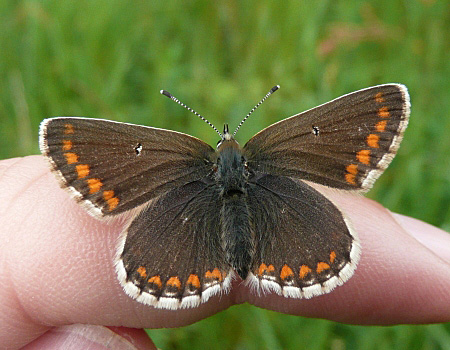Today saw the second twitch of the month, this time with me heading up to hopefully see the White-winged Scoter which had been found at Blackdog at the weekend.
Arriving at the beach a few small Scoter flocks were noted offshore along with numerous Eiders roosting on the shore but a scan of the sea revealed that the main seaduck flock was much further south, some c2miles off in the distance. So off we set along the beach, periodically stopping to scan the sea whenever any Scoter or Eider were seen passing.
As we neared the main flock the pager announced it was still present, but as there had been no other cars in the car park and no sign of any birders along the beach or dunes we were intially puzzled by the message but nevertheless started to scan through the nearest flock of birds. In the meantime after a couple of phone calls we located the other observers who had previously been watching it, and then again embarked on the search from their higher vantage point in the dunes.
With the sun now gaining strength there was an immense glare off the sea which along with the heat haze made the task of relocating it quickly a long shot, but I began a meticulous search through the gathering of some 1500+ Eider and Scoter, with the later being the more distant.
The glare and haze continued to hamper the search for the next half hour or so but with a brief cloudy interlude visibility vastly improved and I embarked on yet another sweep of the flock focusing this time on the area just behind the Eider flock that a few Scoter had drifted into. All of a sudden I locked on to it with the head & bill shape along with the pale grey band on the tip of its dark bill immediately obvious and accordingly quickly made everyone else aware that I'd got it. Typically it quickly dived but having gotten everyone onto the area where it was, when I again picked it up as it resurfaced most of the assembled crowd got on to it before it drifted further back into the main scoter flock where it was lost to view amongst the throng of the other birds as the glare and haze returned.
For the next hour or so the sun beat down on the sea making viewing virtually impossible, and we continued to search for it and the Surf Scoters which were also present in the flock with no luck. Eventually it again clouded over and it was amazing the difference it made with the Velvet Scoters, both male and female, now easy to pick out and soon after the White-winged was again relocated amongst a small group of Velvets and was on show for a few minutes before the group all dived but despite all the Velvets resurfacing one-by-one, there was amazingly no further sign of the White-winged showing how elusive it could be.
Our attentions were then temporarily distracted by one of the Surf Scoters appearing briefly in the flock, and then a little while later I again picked out the White-winged amongst some Velvets and this time we were all able to watch it for a good while as it drifted along and watched as it became more active preening and diving before it was again lost to view amongst the other birds. It even came vaguely near enough for a few record shots to be obtained, with the one below showing it behind a small flock of Velvet and Common Scoter.
The tide was now coming in fast and as a consequence the flock drifted in closer, and with more and more cloud cover viewing was getting better by the minute and we again relocated one of the Surf Scoters which this time was watched for a good time with the record shot of it below being obtained.
With viewing conditions now being the best they had been all day with no haze and the flock coming ever closer, it was great to again relocate the White-winged along the back of the Eider flock, the closest it had been all day and thus giving its best views. Despite it still being very distant photography wise I did manage to get the photo below which is fairly decent, and shows well the shape of the head and bill, and even the fact that you could see through its nostrils (although this was only noticed in the photo after rather than in the field at the time), and also for the first time the white in the wing was also noted.
With us all being happy with the views, plus seeing a nice selection of other birds which in addition to the Surf and Velvets Scoters, included Red-throated Divers, Razorbills and Guillemots, and a few photos of the White-winged in the bag too, we embarked on the long walk back to the car delighted with a new bird.















































